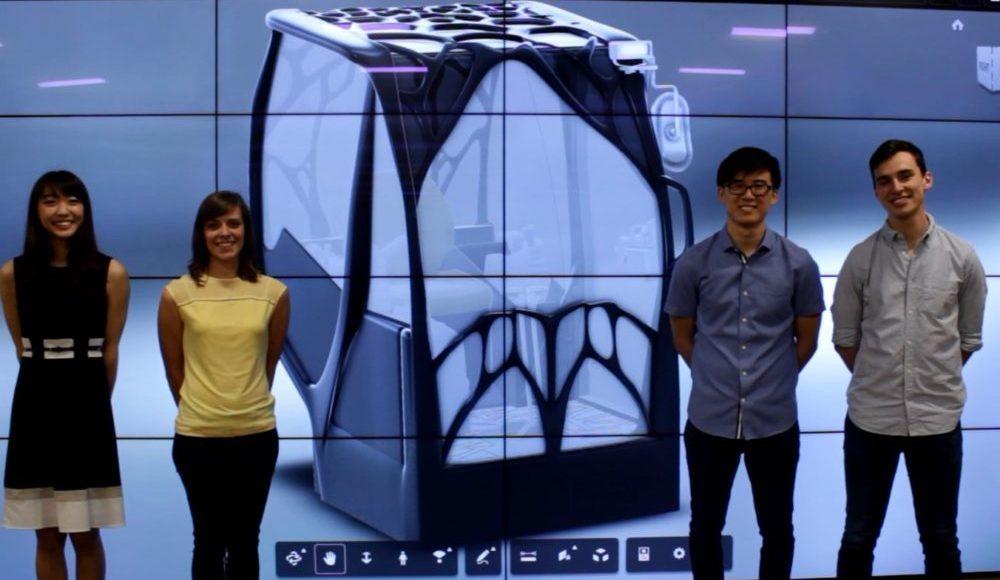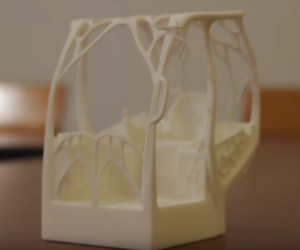A student engineering team from the University of Illinois at Urbana-Champaign (UIUC) has submitted the winning design for an aesthetically pleasing and fully-functional 3D printed excavator cab. The cab will be 3D printed as a functional prototype and the entire excavator will go on display at IFPE and CONEXPO-CON/AGG at the Tech Experience in Las Vegas in March of 2017. The UIUC student engineering team received a $2,000 cash prize that was donated by the National Fluid Power Association. The team will travel to Oak Ridge National Laboratory (ORNL) in Tennessee to watch as their high-tech design is 3D printed in steel.
While a 3D printed excavator may not sound very exciting, if the process works as expected it could help transform the construction industry thanks to cost- and material-saving Topology Optimization (TO), or generative design, software. By using a series of algorithms, the TO software can optimize the amount of material needed to maintain a certain structural durability. In fact, the generative software can often help save on material while increasing the actual strength of the design. The generative structure can also be adjusted to add more strength to certain areas of the cab, which can also be designed to resist certain types of damage. For instance, the cab could be made to be reinforced in certain areas that would typically be crushed in the event of the excavator tipping over.
“When comparing to the industry standard cab, our design is one that has never before been possible. Current cabs will typically be constructed out of a strong material such as steel and welded together in many different steps, exhibiting high structural integrity but limiting creativity to a four-post structure. Our team utilized Topology Optimization, which is a series of mathematical algorithms which was used to minimize material based on specified loading conditions within a given cab envelope. This process provided inspiration for creating a very organic and treelike cab structure, incorporating many curving features not possible by means of traditional manufacturing. We were also able to maximize visibility with gridded roofing and reduce both noise and vibration with structural air gaps,” explained team member Luke Meyer.
Part of the excavator cab challenge was to create an aesthetically pleasing design that was also highly functional. The team from UIUC ended up using a Voronoi pattern for the cab, and while it was chosen because it is a very nice pattern to look at, it is also incredibly rigid and strong. The pattern is based on organic shapes found in nature, and is very commonly used in 3D printing designs because of its structural properties. The pattern is very close to the geometry of the microstructures that are found inside of human bones.
“I think most of us had a strong desire to participate in a senior design project where we could be truly creative; this competition was an ideal choice. It was not like a lot of other options we had, where industry companies approach the university seeking a specific solution. The additive excavator cab design competition had very few limitations on the cab design and essentially encouraged students to showcase our skills and ideas. We could create something totally unique, aesthetically pleasing, yet functional to showcase the capabilities of additive manufacturing (and our team of mechanical engineers at UIUC!),” Meyer continued.
 The UIUC design team included Jowon Kim, Sharon Tsubaki, Luke Meyer, Naomi Audet and Andrew Peterman, and they were one of several student teams working on the full excavator design that will be on display at CONEXPO-CON/AGG. A group of Georgia Tech graduate engineering students will be designing a 3D printable boom and bucket featuring integrated hydraulics. The goal of that design will be to decrease the weight of the excavator, the cost of manufacturing materials and the maintenance cost. Additionally, University of Minnesota students will be designing a hydraulic oil heat exchanger and cooling system that is also expected to reduce the size and weight of the excavator while increasing its efficiency. Discuss further in the 3D Printed Excavator Cab forum over at 3DPB.com.
The UIUC design team included Jowon Kim, Sharon Tsubaki, Luke Meyer, Naomi Audet and Andrew Peterman, and they were one of several student teams working on the full excavator design that will be on display at CONEXPO-CON/AGG. A group of Georgia Tech graduate engineering students will be designing a 3D printable boom and bucket featuring integrated hydraulics. The goal of that design will be to decrease the weight of the excavator, the cost of manufacturing materials and the maintenance cost. Additionally, University of Minnesota students will be designing a hydraulic oil heat exchanger and cooling system that is also expected to reduce the size and weight of the excavator while increasing its efficiency. Discuss further in the 3D Printed Excavator Cab forum over at 3DPB.com.
Here is a video of the students presenting their design:
[Sources/Images: Equipment World, Manufacturing Tomorrow]
Subscribe to Our Email Newsletter
Stay up-to-date on all the latest news from the 3D printing industry and receive information and offers from third party vendors.
You May Also Like
Further Understanding of 3D Printing Design at ADDITIV Design World
ADDITIV is back once again! This time, the virtual platform for additive manufacturing will be holding the first-ever edition of ADDITIV Design World on May 23rd from 9:00 AM –...
3D Printer Maker EVO-tech Reborn as NEVO3D — Once More With Feeling
EVO-tech was a 3D printing service and original equipment manufacturer established in 2013 and based in Schörfling am Attersee, Austria. The company produced high-quality material extrusion systems featuring linear bearings,...
3D Systems Brings 3D Printed PEEK Cranial Implant to the U.S. with FDA Clearance
For more than 10 years, 3D Systems (NYSE:DDD) has worked hand-in-hand with surgeons to plan over 150,000 patient-specific cases, and develop more than two million instruments and implants from its...
CDFAM Returns to Berlin for Second Annual Symposium
The second CDFAM Computational Design Symposium is scheduled for May 7-8, 2024, in Berlin, and will convene leading experts in computational design across all scales. Building upon the first event...

































